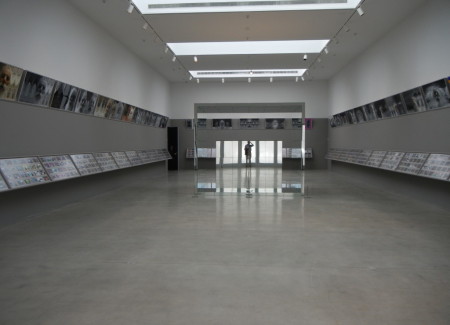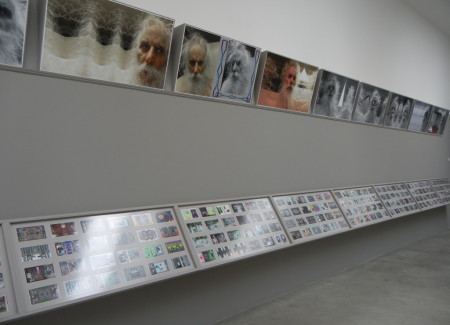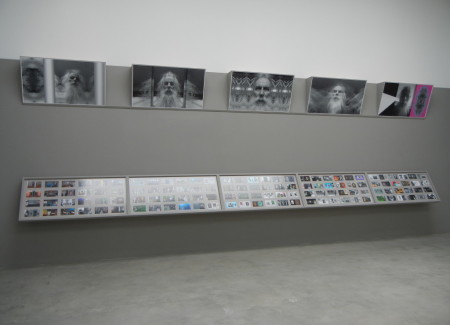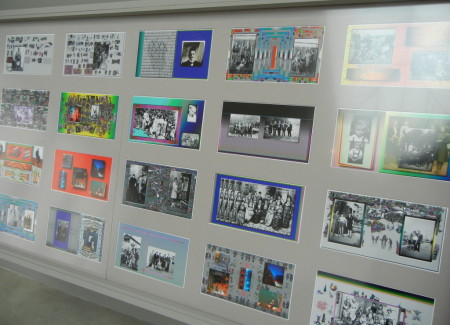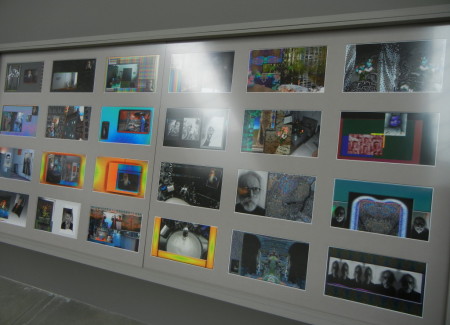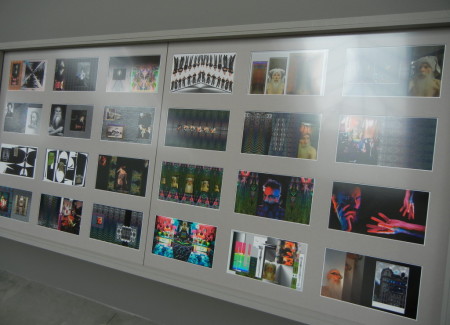JTF (just the facts): A total of 778 color photographs, displayed against grey/white walls in the large, single room gallery space. 34 of the works are large scale color prints, mounted on angled grey boxes and placed roughly edge to edge high on the walls. The rest of the works are shown on 31 panels, each containing 24 small color prints mounted together under plexiglas (a total of 744 prints). The show also includes a mirrored sculpture in the center of the gallery. A dowloadable app ALBUM 2 contains digital versions of all the artworks and is available for free (here); a small spiral bound catalog (24 pages) is available from the gallery for $30. (Installation shots below.)
Comments/Context: In his smart book How Music Works, David Byrne makes a compelling argument that across the centuries, musicians have constantly adapted their music to the venues in which it was to be played, the particular acoustics of a French court salon, a basement folk club, a disco, or a football arena leading to compositions that were consciously optimized to sound good in those spaces (and resultingly, not so good in others). He makes a related point about the invention of the Sony Walkman and the private listening experience that has now become ubiquitous via iPods and mobile phones, and the potential for recordings that take advantage of the intense detail and nuance available in this specific personal “venue”.
These broad insights are surprisingly applicable to the sweep of the visual art world, with the optical and spatial dynamics of a dark church, a plush salon, a minimalist white cube, or an empty industrial space of increasingly monumental scale influencing the subject matter, size, and coloration of artworks in various mediums. It is also similarly true that digital devices represent a promising new venue for the visual arts, especially for photography and video, assuming artists can effectively adapt themselves to the constraints (and advantages) of these new platforms.
Lucas Samaras’ new show at Pace is being held in a voluminous gallery space, but it is really the first photography show I have encountered where the images seem to have been constructed with viewing on a digital device as their primary mode of experience (while there is a blurring of a definitional boundary with computer/net art here, I believe Samaras remains largely centered on a photographic paradigm). And contrary to my usual bias toward the physical in photography, the in-real-life version of this body of work is in many ways a sideshow (even though it is expansive and impressive in its own way); for the main attraction, download the free app instead (linked above) and see Samaras’ photographs in the backlit, high intensity, computer screen environment for which he intended them.
The reason I say this is that in the blank, silent austerity of a white cube, Samaras’ new works alternately look crazy and/or gimmicky, like images by a guy who just discovered software manipulation and went to town using every feature and effect available in the drop down menus. Starting with an archive of family photos and self portraits going back to his childhood (including everything from vintage snapshots and formal group portraits to recent nudes, selfies and candids), Samaras has unleashed a staggering torrent of digital technology – beveled edges, mirroring, stripes, filters, gradients, color tweaking, rippling, digital drawing, geometric patterns, repetition, frames – you name it, he’s tried it. And in this big white box, it all feels anachronistically out of place, especially the energized eye popping colors and meticulously tiny graphic details – it’s an example of the wrong “music” playing in the wrong venue and the unintended reverberations creating conceptual dissonance.
But settle into your favorite chair, pull out your device, and engage with the app, and suddenly Samaras’ improvisational flights of fancy don’t seem so odd. Instead of being overloaded with images in mile long grids, the user experience follows the gentle rhythm of clicking swipes, each image running full screen. As the show’s title implies, the process feels much more like progressive paging through an album, with the same intimacy and close attention that activity represents. In the context of a phone, Samaras’ orgy of over-the-top computer graphics seems altogether expected – the digital layering, the images floating in undefined colored space, the iterative recontextualization, the density of detail, it all feels remarkably normal and well suited to the sharply technical surroundings of a hard edged iPad.
Of course, Samaras has been testing the boundaries of technology and self portraiture since the 1960s, going back to his hand massaged manipulated Polaroids, so the idea that he should want to continue to reinvent himself (and his artistic adventures) in the digital realm isn’t surprising (a review of his 2012 digital exploits is here). Seen together, these new images are like an ecstatic fever dream, his hyperactive brain processing the strands of his life on overdrive, constantly riffing and reworking himself and his memories, still building, still searching for new perspectives.
This almost manic boiling over of archival reuse and graphical experimentation delivers a more subtle and nuanced picture of time and aging than we might expect. Before our eyes, Samaras moves through nearly all the stages of his life (and even further back into the history of his family), particularly back and forth between the visage of a clean shaven young man and a haggard, grizzled elder with a bushy grey beard. The recent images of his later years are unflinching, especially those in the hospital, where his bedraggled hair hangs limp against the standard issue gown. He then doubles and triples his face into jittering mirrored multiples, adding in splashes of psychedelic color to somber black and white studies or centering himself amid an explosion of digital mark making and pattern generation. Hands, faces, eyeglasses, fingers – they all become raw material for distorted investigative concoctions, where raw bodily honesty meets iterative plastic transformation. It’s as if he’s methodically retracing a long career of artistic steps, pulling them through a digital sieve and reimagining them once again; or perhaps he’s just redefining how memory will function in the singularity.
While Samaras’ display has all the trappings of unbridled, all-over-the-place creativity in dire need of a much tighter edit, the bursting energy of the unrelenting flow of imagery on view, with its disconnected detours to orchids, fountains, rubble, snow, landscapes, architecture and other shards of pictures and metaphors, is undeniably impressive in its too muchness and has an additive, building effect when seen in the app. He’s opened up the throttle, pushing himself ever faster, unconcerned by the messiness of the speed. As a result, his ideas and imaginings spill everywhere, seemingly doubling again and again, filling the unconstrained electronic space with a limitless refrain of “who am I?”, like an endlessly evolving loop of code left running. But somewhere in all this bustling activity are the seeds of a new paradigm of delivery of and engagement with contemporary photography, so even if his firehouse of imagery overruns your ability to process it all, spend a moment thinking about the barriers Samaras is quietly tearing down.
Collector’s POV: The works in this show are priced as follows. The larger single image prints are $35000 each, while the set of 720 prints is $720000; the mirrored sculpture is $1000000. Samaras’ work has only been sporadically available in the secondary markets in recent years, with recent prices ranging from roughly $4000 to $195000.
